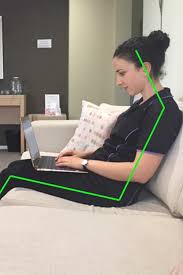

Slouching on the couch while watching TV is a common habit that can lead to significant neck strain.
This article delves into the mechanics of how such posture affects the neck, the anatomical and physiological implications, and the potential long-term consequences.
By understanding these factors, readers can become more aware of the importance of maintaining proper posture during leisure activities.
Article Index:
- Introduction
- Understanding Neutral Spine Alignment
- The Mechanics of Slouching
- Anatomical Implications of Poor Posture
- Physiological Effects on the Neck
- Long-Term Consequences of Chronic Slouching
- Conclusion
Introduction
In today’s digital age, prolonged sitting has become a routine part of life, particularly during leisure activities like watching television.
Many people unconsciously adopt a slouched posture on couches, with their necks craning forward or shoulders rounding, unaware of the strain this position imposes.
Over time, this poor posture can lead to discomfort, stiffness, and even chronic pain in the neck and upper back.
This article delves into the mechanics of how slouching affects the neck, the anatomical and physiological consequences, and the potential long-term effects, highlighting the critical role that proper posture plays in preventing these issues.
Understanding Neutral Spine Alignment
A neutral spine preserves the natural curves of the cervical (neck), thoracic (mid-back), and lumbar (lower back) regions, maintaining balance and even weight distribution.
This alignment minimizes stress on the musculoskeletal system, reducing the likelihood of discomfort, strain, or injury.
Proper posture allows muscles, ligaments, and joints to work efficiently, preventing wear and tear.
For example, when sitting upright with feet flat on the floor, the spine remains neutral, supporting the body without excess strain.
In contrast, slouching while watching TV places undue pressure on the lower back and neck, often leading to chronic pain and musculoskeletal issues over time.
What Is Slouching, Really? A Postural Crime in Progress
Slouching might appear harmless—just a casual, relaxed posture—but underneath that chill exterior lies a full-scale rebellion against your spine.
At the heart of this rebellion are two usual suspects: forward head posture and a rounded upper back, also known as thoracic kyphosis that strains shoulder muscles. Together, they turn the spine’s elegant S-curve into something more like a question mark.
Not the kind that inspires curiosity—more like the one that asks, “Why does my neck hurt every day?”
The Forward Head Snowball: One Inch, Ten Extra Pounds
Biomechanical research tells a clear and alarming story. For every inch the head moves forward, the effective weight experienced by the neck increases by approximately ten pounds.
This is based on the work of spinal experts like Dr. Kenneth Hansraj, whose 2014 study gained wide attention.
Imagine balancing a bowling ball upright on your spine—then imagine holding it three inches out in front. That is what your neck muscles are managing every time you lean into your screen.
So, if the average human head weighs around 12 pounds and shifts just 3 inches forward, the neck is suddenly supporting 36 pounds of force.
That is like strapping a small bulldog to your skull and pretending everything’s fine.
Tech Neck: The Epidemic We Texted Into Existence
This postural nightmare has a modern name: tech neck. It is the result of hours spent staring down at phones, laptops, or tablets.
A 2022 study in the Spine Journal reported that nearly 79% of young adults who use digital devices for more than four hours a day experience symptoms associated with tech neck. And no, switching hands doesn’t solve the problem.
This posture, repeated daily, leads to microtraumas in the muscles and ligaments of the neck. Over time, the damage adds up.
Chronic stiffness, muscle spasms, cervical disc compression, and even migraines can creep in—turning simple texting into a long-term injury.
From Lazy Slouch to Lasting Injury: The Slippery Slope
What begins as a moment of laziness can snowball into structural damage. Neck muscles fatigue quickly when overworked.
The burden then shifts to ligaments, which stretch out and weaken. Discs start to compress. And to top it off, poor posture reduces chest expansion, making breathing more shallow.
In the end, slouching is not just about how you look in a photo—it is about how your spine, muscles, and even your lungs perform under constant stress.
Straightening up is not just aesthetic; it is survival.
Anatomical Implications of Poor Posture
Maintaining a slouched posture can trigger significant anatomical changes, creating a cascade of issues that affect the neck and surrounding structures:
- Muscle Imbalance: Slouching causes the anterior neck muscles, such as the sternocleidomastoids, to become overly shortened due to prolonged flexion. Simultaneously, the posterior muscles, including the trapezius and splenius capitis, are overstretched. This imbalance disrupts the natural muscular harmony, leading to stiffness, pain, and reduced range of motion. Over time, this dysfunction can make even basic head movements uncomfortable and contribute to chronic neck pain.
- Joint Compression: The forward head posture associated with slouching places increased stress on the cervical facet joints, small articulations that guide spinal movement. This added compression can lead to joint irritation, inflammation, and pain. Repeated strain may accelerate the development of arthritis in these joints, exacerbating discomfort and reducing mobility.
- Nerve Impingement: Poor spinal alignment can result in compressed nerve roots in the cervical spine. This compression may lead to radiating symptoms, such as sharp pain, numbness, or tingling sensations in the shoulders, arms, and hands. These symptoms, often associated with conditions like cervical radiculopathy, can interfere with daily activities and may require medical intervention if persistent.
Physiological Effects of Slouching on Your Neck
Beyond the anatomical changes it causes, slouching has significant physiological impacts that extend beyond the neck itself, influencing overall body function and well-being.
- Reduced Blood Flow: Prolonged poor posture, such as slouching, can constrict blood vessels in the neck and surrounding areas. This reduction in circulation deprives the muscles of adequate oxygen and nutrients, leading to muscle fatigue and stiffness. Over time, this can weaken the neck’s structural support and increase the likelihood of strain or injury during routine activities.
- Decreased Lung Capacity: A hunched posture compresses the chest cavity, restricting the ability of the lungs to fully expand. This limits oxygen intake, resulting in diminished energy levels and impaired cognitive function due to reduced oxygen delivery to the brain and body. Over extended periods, this can contribute to feelings of lethargy and poor physical performance.
- Increased Muscle Tension: The prolonged strain on neck and shoulder muscles caused by slouching creates chronic tension. This often leads to discomfort and tension headaches, which originate from tightened muscles at the base of the skull. Such tension can further compound neck pain, creating a cycle of discomfort and stress that impacts daily activities and quality of life.
Long-Term Consequences of Chronic Slouching
Persistent poor posture, such as slouching, can have long-term consequences that significantly affect spinal health and overall well-being:
- Degenerative Disc Disease: When the neck is constantly misaligned, the cervical discs endure increased pressure and uneven stress. This accelerates the natural wear-and-tear process, potentially leading to conditions like bulging or herniated discs. These issues may cause localized pain or radiating symptoms such as numbness, tingling, or weakness in the arms. Left unchecked, such damage can necessitate medical interventions, including physical therapy or even surgery.
- Chronic Pain Syndromes: Over time, prolonged muscle strain and joint stress caused by poor posture can evolve into chronic pain syndromes. This persistent discomfort affects not only physical health but also mental well-being and daily life activities, often requiring long-term management strategies.
- Postural Deformities: Habitual slouching can lead to permanent changes in spinal curvature. Conditions like kyphosis, a forward rounding of the back, can result from sustained poor posture. Severe cases may cause mobility limitations, muscle imbalances, and even require surgical correction, highlighting the critical need for posture awareness and early intervention.
Conclusive Analysis
Slouching on the couch may feel like the perfect way to unwind, but your neck disagrees.
Spending hours in that curved, forward-leaning posture puts serious strain on your cervical spine.
For every inch your head tilts forward, your neck muscles bear an extra 10 pounds of stress—that is like carrying a bowling ball around all day!
Over time, this contributes to forward head posture, muscle fatigue, and chronic neck pain.
The good news?
You can avoid these problems by staying posture-aware, even during Netflix marathons.
Supporting your lower back, keeping your head aligned with your spine, and taking breaks to stretch can work wonders.
Remember, small adjustments today can prevent big aches tomorrow.
Your neck will be happier, and you will still enjoy your favorite shows—just without the nagging pain tagging along!
References:


